Preprint
Article
Effects of Probiotics in Adults with Gastroenteritis: A Systematic Review and Meta-Analysis of Clinical Trials
Altmetrics
Downloads
126
Views
38
Comments
0
A peer-reviewed article of this preprint also exists.
This version is not peer-reviewed
Submitted:
04 September 2023
Posted:
06 September 2023
You are already at the latest version
Alerts
Abstract
Probiotics have been widely used in gastroenteritis due to acute and chronic illnesses. However, evidence supporting the effectiveness of probiotics in different health conditions are inconclusive and conflicting. The aim of the study was to review existing literature on the effects of probiotics in gastroenteritis among adults. Only original articles on clinical trials that demonstrated the effects of probiotics in adults with gastroenteritis were used for this analysis. Multiple databases such as PubMed, Google Scholar, MEDLINE and Scopus databases were searched for the data. The study followed standard procedures for data extraction using PRISMA flow chart. A quality appraisal of the selected studies was conducted using CADIMA. Finally, a meta-analysis was conducted. Thirty-five articles met the selection criteria; of them, probiotics were found effective in the treatment and/or prevention of chronic inflammatory bowel disease (IBD) including ulcerative colitis and Crohn’s disease in 17 (49%), and the treatment of pouchitis in 4 (11.4%), antibiotic-induced diarrhea in 3 (8.6%), Helicobacter pylori infection in 2 (5.7%) and diverticulitis in 1 (2.9%), while the remaining 7 (20%) were ineffective and 1 study results were inconclusive. Meta-analysis, on the contrary, didn’t demonstrate any significant protective effects of probiotics. Having a τ² value of zero and I² of 6%, the studies were homogeneous and had minimum variances. Further studies are suggested to evaluate the beneficial effects of probiotics in IBDs and other chronic bowel diseases.
Keywords:
Subject: Public Health and Healthcare - Public Health and Health Services
1. Introduction
Gastroenteritis poses serious public health concerns in both high- and low-income countries. It is one of the leading causes of morbidity and mortality worldwide [1]. Globally, the estimated annual cost of healthcare and loss of productivity due to gastroenteritis is about $60 billion of which developing countries bear the highest burden [1,2]. According to the Centers for Disease Control and Prevention (CDC), gastroenteritis is the most prevalent infectious disease syndrome in the United States, accounting for over 350 million illnesses annually and about 200,000 deaths, with the elderly having higher risks of mortality [3,4]. The symptoms of gastroenteritis could range from mild asymptomatic infections to life-threatening conditions and deaths [5].
Probiotics are supplements or foods that contain live non-pathogenic microorganisms, which can maintain and improve microbial balance in the gastrointestinal tract [6]. Some beneficial effects of probiotics relevant to the treatment and prevention of gastroenteritis include: reduction of invasion and colonization of the intestine by pathogenic organisms, modification of host immune response, and reduction of pH in the intestine [6,7]. Although, some studies confirmed that probiotics have anti-inflammatory and antimicrobial effects and help maintain good bacteria in the gut, results from some other studies are inconclusive and conflicting [8]. Use of specific probiotic preparations should be based on evidence from well-designed clinical trials. Therefore, the purpose of this study was to present the results of a systematic review and meta-analysis carried out to examine the effects of probiotics in adults with acute and chronic gastroenteritis of multiple etiologies.
2. Materials and Methods
A systematic literature search was conducted from February – May, 2021 using PubMed database as the primary data source. Other research databases included were Google Scholar, MEDLINE, and Scopus. The search keywords in PubMed were “effects of probiotics in gastroenteritis”, Medical Subject Headings (MeSH) Terms were: "effect*" OR "outcomes" OR "impact" OR "efficacy*" OR "efficaciousness*" AND "Probiotics" AND "Gastroenteritis" AND "Clinical Trial".
Articles which met the following criteria were included in the review: 1) Studies published between years 1990-2022; 2) Only clinical trial study designs; 3) Studies related to the effects of probiotics in gastroenteritis; 4) Studies with partcipants between 19 – 55 years of age; 5) Full text articles; and 6) Articles written in English language. Figure 1 shows the detailed search strategies for this study using the preferred reporting items for systematic reviews and meta-analyses (PRISMA) [9].
Quality appraisal methods
Studies were appraised for quality using CADIMA [10]. CADIMA is a free tool which is available online for managing articles for systematic review including automated duplicate removal, uploading PDF articles, and documentation fo the review process. Through CADIMA, standards for critical appraisal and the rating scale were defined. We followed the critical appraisal tools for systematic reviews developed by the University of Adelaide, South Australia [10]. A rating scale from 0 to 4 was based on the following criteria: (1) Sample size: greater than 30 = 1; smaller sample = 0; (2) Randomized controlled trials = 1; not randomized, no controls = 0; (3) Studied both safety and efficacy = 1; otherwise = 0; (4) Standard and objective evaluation criteria = 1, otherwise = 0. Based on the above-mentioned criteria, we rated each of the 35 studies independently from a range of 0 to 4.
3. Results
Of the 1,865 research articles identified through database search, 1,544 articles were excluded for not being done in adults. Of the remaining 321 studies, 190 were excluded because the studies did not involve clinical trials; 84 were excluded for not having full articles available; and 12 were excluded for studies not meeting the eligibility criteria, and/or not being related to gastroenteritis. The results presented below include analyses of 35 studies for the systematic review (Figure 1).
The total sample size for the 35 studies was 4,577, ranging from 15 to 777 samples in individual study, with a median of 44. Only 12 studies (34%) had a sample size of more than 100.
3.1. Type of Illnesses Associated with Diarrhea
We found that the majority of the studies (51%, 18 of 35) focused on effectiveness of probiotics in the treatment of IBDs (ulcerative colitis and Crohn’s disease), 11% (4 of 35) of the study patients had pouchitis (inflammation that occurs in the lining of a pouch created during surgery to treat ulcerative colitis or certain other diseases), about 9% (3 of 35) had antibiotic-induced diarrhea, 6% (2 of 35) had diarrhea due to Helicobacter pylori, and one each (2.9%) had diverticulitis or acute watery diarrhea due to Vibrio cholerae and enterotoxigenic Escherichia coli infection, (Figure 2).
3.2. Probiotic Strains Used and Follow-up
Most of the studies (60%, n = 21) administered multiple strains of probiotics while the remaining 14 studies administered single strain of probiotics. The most commonly administered probiotic strains were Lactobacilli, Bifidobacteria, Streptococcus, and Escherichia. In a few studies, probiotics were administered as an adjuvant therapy with another conventional treatment, such as an anti-inflammatory drug for IBDs [15,20,32], rehydration therapy for acute watery diarrhea [30], or with a combination of treatments comprising antibiotics and proton pump inhibitor (PPI) (Esomeprazole) for chronic gastritis or duodenal ulcer due to H. pylori infection [43].
Patients’ follow-up protocols varied widely, ranging from as low as 10 days to 2 years depending on the illness type. Ten studies followed patients for 12 months or more, 12 studies followed patients for 3-11 months while another 14 followed patients for 3 months or less.
3.3. Quality Appraisal Findings
Due to having no major inter-observer variations in the evaluation of the quality of the studies, an average of the 4 scores was presented in Table 3. Out of 35 studies reviewed, 19 (55%) scored high (4 out of 4), 15 (43%) scored moderate (3 out of 4), and only one was rated poor (2 out of 4). Among the 27 studies which were proven effective for the treatment of probiotics, the majority (63%, n = 14) were of high quality (score 4 out of 4), 44% (n = 12) scored moderate quality (score 3 out of 4), and only 1 (4%) scored poor rating (score 2 out of 4).
3.4. Efficacy and Safety of Probiotics
The outcome measures were considered favorable if studies reported resolution, remission, improvement or no relapse of gastroenteritis after treatment. Of the 35 studies reviewed, 27 (77%) showed a favorable response after using probiotics, 7 (20%) showed that probiotics were ineffective, and 1 study conducted in Iran [34] was inconclusive (Table 1). Probiotics were most effective in the treatment or prevention of gastroenteritis due to IBDs (Figure 2). Of the various forms of probiotics, a mixture of multiple probiotic strains, in the form of VSL #3, was found most effective in treating patients with IBDs [22,29,39,40] and drug-induced enteropathy [31,35]. However, probiotics were found ineffective in five studies in patients with ulcerative colitis or Crohn’s diseases [12,14,17,26,27], and also in two other studies – one in 20 patients with pouchitis in Finland [23], and the other study in 183 patients with a severe form of acute watery diarrhea due to V. cholerae and E. coli infections in Bangladesh [30] (Table 1).
All probiotics administered in these studies, including those which were proven ineffective, were well tolerated by patients and no adverse side effects were reported. However, several studies cautioned the use of probiotics among immunocompromised patients due to safety concerns in such patients [8,50].
3.5. Effectiveness of Probiotics, as Evaluated by Meta-Analysis of 22 Clinical Trials
Due to the unavailability of relevant data, meta-analysis was conducted using 22 out of 35 (63%) studies. Table 2 shows relative risk and 95% confidence intervals (CIs) of the effect of probiotics in each study. Risk ratios observed a protective effect in 50% of the studies (n = 11); however, 95% CI included 1 in each of them. The pooled relative risk was 0.99, with 95% CI being 0.90 and 1.09. Test for the overall effect showed a p-value of 0.37, meaning that there was not enough evidence to indicate that the intervention had a significantly more protective effect compared to controls. The value of τ² indicated low variation of true effects. The Higgins H test (I²) was 6%, indicating a homogeneous nature of the weights of the studies evaluated in the meta-analysis.
In Figure 3, the Forest Plot, risk ratio and 95% CI included the line of no effect, and the p-value for overall effect was 0.85. Because of negligible heterogeneity among the studies, we can rely on the aggregated estimate more as the majority or all individual studies reached the same conclusion.
3.6. Overall Risk of Bias by Categories of Bias
As shown in Figure 4 and Figure 5, the domains evaluated in this review were as follows: (a) Random Sequence Generation: It is a form of selection bias (biased allocation to interventions) resulting from insufficient generation of a randomized sequence; (b) Allocation Concealment: It is also a selection bias (biased allocation to interventions) owing to insufficient allocation concealment prior to assignment; c) Blinding of Participants and Personnel: This is a performance bias due to participants' and personnel's knowledge of the assigned interventions during the study; d) Blinding of Outcome Assessment: This is a detection bias due to outcome assessors' knowledge of the allocated interventions; e) Incomplete Outcome Data: This is an attrition bias due to the quantity, character, or treatment of incomplete outcome data; f) Selective Reporting: This is a bias in reporting owing to the selective reporting of outcomes; g) Other Bias: This category encompasses biases caused by issues not covered elsewhere in the table. In Figure 4 and Figure 5, the rating scales of bias were high (red), low (green), and unclear (yellow).
Based on Figure 5, only one study [36] (Steed et al. 2010) was judged having ‘high risk’ of bias for two domains: (1) Random Sequence Generation (selection bias). Reviewer’s comments: There was no description of the randomization process, and the domain selection reporting (reporting bias); (2) Incomplete Outcome Data (attrition bias). Reviewer’s comments: handling of incomplete outcome data was not described in detail.
3.7. Assessment of Publication Bias
Figure 6 shows that the larger studies cluster around the top of the plot, whilst smaller studies are spread across the bottom of the plot. This is an ideal funnel plot where the included studies have scattered either side of the overall effect line in a symmetrical manner. There is no severe asymmetry to either side, so we conclude that publication bias was not present.
4. Discussion
4.1. Effective Treatment with Probiotics
Out of 35 studies that were investigated for the systematic review, our meta-analysis included 22 (63%) studies. The overall results of systematic review and meta-analysis demonstrated a mixed effect of probiotics therapy in gastroenteritis in adults. However, studies found that either short-term or long-term administration of probiotics were safe.
Our analysis suggests that based on the systematic review per se, probiotics were an effective therapeutic alternative or an adjuvant therapy for gastroenteritis in 27 out of 35 (77%) of studies, whereas meta-analysis of the aggregated data did not provide enough evidence to support statistically significant protective effects of probiotics in the study subjects with gastroenteritis. The systematic analysis also showed that probiotics were not effective in 7 (20%) patients with gastroenteritis.
Disease conditions that improved on probiotic treatment mostly included IBDs due to ulcerative colitis and Crohn’s disease. Other disease entities were chronic gastritis, pauchitis, H. pylori infections, and drug-induced enteropathies. There were no particular disease entities that were found ineffective in the treatment with probiotics. In this review, a combined therapy of probiotics with either nonsteroidal anti-inflammatory drugs, proton pump inhibitors, or antibiotics showed effective results in the treatment of IBDs, chronic gastritis and infection due to H. pylori. Probiotics were also effective in the disease prevention or prevention of relapses in 8 studies [11,21,25,26,27,37,42,44]. Findings of this review also suggested that probiotics were useful in improving patients’ quality of life in two studies (29, 41) in addition to reducing morbidity due to chronic gastroenteritis.
Our systematic review data are consistent with earlier reports which confirmed the effectiveness of probiotics in gastroenteritis. However, the effectiveness of probiotics is dependent on dose, strains used in probiotics, duration of therapy, and the type of illnesses [7,47]. One may compare the effects of probiotics in adults with the ones described in studies in children, primarily to evaluate the effectiveness of probiotics on gastroenteritis due to different etiologies [48].
4.2. Ineffectiveness of Probiotics
It is noteworthy that approximately 20% (n = 7) of the studies reported that probiotics were not effective in treating gastroenteritis, which creates an interesting discrepancy. The reasons for an ineffective outcome of these studies are mostly speculative at this point. The study of acute watery diarrhea due to V. cholerae and E. coli infections in Bangladesh [30] were more severe in nature compared to gastroenteritis due to other causes, and these patients with acute watery diarrhea needed intravenous rehydration. In such severe form of diarrheal diseases, the effectiveness of probiotics remains a question. However, in addition to the results of using a lyophilized form of Streptococcus feacium SF68, further studies may be evaluated by using other forms of probiotics or using a combination of probiotics and antibiotics in acute diarrhea. In the other cases of failure, all happened to be in patients with IBDs. Matsuoka et al (2018) [27] emphasized that the reason of lack of effectiveness may be due to inadequate dose of probiotics administered, the route of administration, or the inability to confirm improvement by using endoscopic and/or imaging procedures. Another report having no improvement after a synbiotic therapy in patients with mild-to-moderate degree of IBDs could be attributable to a small sample size and absence of more specific and objective biomarkers of inflammation such as fecal calprotectin and histologic scores to diagnose the disease [12].
4.3. Safety Issues
Our review did not find any safety concerns of probiotics in any of the studies. However, several studies described and warned about major safety issues in using probiotics, including but not limited to, systemic infections, deleterious metabolic activities, excessive immune stimulation in susceptible individuals, gene transfer and gastrointestinal side effects [49,50]. Other studies cautioned that the administration of probiotics among vulnerable populations, especially immunocompromised individuals should be carefully considered [8,50]. However, a solution to this conundrum may lay in the idea of making the report of adverse events involving probiotics in a mandatory and standardized way, thereby improving safety of products and reliability of data [51].
4.4. Limitations of the Study
One limitation of this systematic review and meta-analysis is that it focused on limited sources of studies available for synthesis using PubMed, MEDLINE, Google Scholar, and Scopas. Our study cannot be generalized because only studies published in English language and those having free full texts were reviewed. However, the nature of a comprehensive systematic review, using 30 years of timeframe of the published reports, and inclusion of study findings of radomized controlled clinical trials only may limit possibilities of bias. In addition, risks of bias assessment were low in all studies except one in our meta-analysis. A very low value (6%) of Higgins test (I²) of heterogeneity also indicates a homogeneous nature of the studies evaluated.
5. Conclusions
Our meta-analysis provided new information in contrast to the data obtained from the systematic review on the effectiveness of probiotics in gastroenteritis in adults. Even the data gathered from the systematic review had a mixed effect of probiotics – although probiotics were effective in the treatment and reducing relapses of chronic inflammatory gastrointestinal conditions in majority of the adults (78%), the review shows that probiotics are ineffective in about 20% of the patients. More importantly, the pooled data of the meta-analysis demonstrated no statistically significant protective effects of using probiotics. However, there were paucity of data from developing countries. Further studies are needed to confirm whether probiotics can restore the gut microflora and improve gastroenteritis as a single therapy or as an adjunct therapy with other conventional treatments of the infection.
Author Contributions
Conceptualization, A.K.M; Data Extraction, A.K.M., A.F.A. and S.M.; Validation, A.K.M. S.M., M.K.M.; Original Draft Preparation, A.F.A; Review & Editing, A.K.M., A.F.A. S.M. and M.K.M.
Funding
This research received no external funding.
Conflicts of Interest
The authors declare no conflict of interest.
References
- Bartsch, S.M.; Lopman, B.A.; Ozawa, S.; Hall, A.J.; Lee, B.Y. Global economic burden of norovirus gastroenteritis. PloS One 2016, 11, e0151219. [Google Scholar] [CrossRef] [PubMed]
- Nguyen, G.T.; Phan, K.; Teng, I.; Pu, J.; Watanabe, T. A systematic review and meta-analysis of the prevalence of norovirus in cases of gastroenteritis in developing countries. Medicine 2017, 96, e8139. [Google Scholar] [CrossRef] [PubMed]
- Graves, N.S. Acute gastroenteritis. Prim Care Clin Office Pract 2013, 40, 727–741. [Google Scholar] [CrossRef] [PubMed]
- Jagai, J.S.; Smith, G.S.; Schmid, J.E.; Wade, T.J. (2014). Trends in gastroenteritis-associated mortality in the United States, 1985–2005: Variations by ICD-9 and ICD-10 codes. BMC Gastroenterol 2014, 14, 211. [Google Scholar] [CrossRef]
- Hall, A.J.; Patel, M.M.; Lopman, B.A.; Armah, G.E. Part 2: Viral Diseases - Norovirus. In Hunter's Tropical Medicine and Emerging Infectious Disease, 9th ed.; Magill, A.J.; Ryan, E.T.; Hill, D.R.; Solomon, T. Eds.; Saunders Elsevier Inc., China, 2013; pp. 280-282.
- Williams, N.T. Probiotics. Am J Health Syst Pharm 2010, 67, 449–458. [Google Scholar] [CrossRef]
- Tomasik, P.; Tomasik, P. Probiotics, non-dairy prebiotics and postbiotics in nutrition. Appl Sci 2020, 10, 1470. [Google Scholar] [CrossRef]
- Wilkins, T.; Sequoia, J. Probiotics for gastrointestinal conditions: A summary of the evidence. Am Fam Physician 2017, 96, 170–178. [Google Scholar]
- Liberati, A.; Altman, D.G.; Tetzlaff, J.; Mulrow, C.; Gøtzsche, P.C.; Ioannidis, J.P.; et al. The PRISMA statement for reporting systematic reviews and meta-analyses of studies that evaluate healthcare interventions: Explanation and elaboration. BMJ 2009, 339, b2700. [Google Scholar] [CrossRef]
- Joanna Briggs Institute.JBI Critical Appraisal Tools. Available online: https://jbi.global/critical-appraisal-tools (accessed on 3 May 2023).
- Alberda, C.; Marcushamer, S.; Hewer, T.; Journault, N.; Kutsogiannis, D. Feasibility of a Lactobacillus casei drink in the intensive care unit for prevention of antibiotic associated diarrhea and Clostridium difficile. Nutrients 2018, 10, E539. [Google Scholar] [CrossRef]
- Altun, H.K.; Yildiz, E.A.; Akin, M. (2019). Effects of synbiotic therapy in mild-to-moderately active ulcerative colitis: A randomized placebo-controlled study. Turk J Gastroenterol 2019, 30, 313–320. [Google Scholar] [CrossRef]
- Bjarnason, I.; Sission, G.; Hayee, B. A randomised, double-blind, placebo-controlled trial of a multi-strain probiotic in patients with asymptomatic ulcerative colitis and Crohn’s disease. Inflammopharmacol 2019, 27, 465–473. [Google Scholar] [CrossRef] [PubMed]
- Derwa, Y.; Gracie, D.J.; Hamlin, P.J.; Ford, A.C. Systematic review with meta-analysis: The efficacy of probiotics in inflammatory bowel disease. Aliment Pharmacol Ther 2017, 46, 389–400. [Google Scholar] [CrossRef] [PubMed]
- Fan, H.; Du, J.; Liu, X.; Zheng, W.W.; Zhuang, Z.H.; Wang, C.D.; et al. Effects of pentasa-combined probiotics on the microflora structure and prognosis of patients with inflammatory bowel disease. Turk J Gastroenterol 2019, 30, 680–685. [Google Scholar] [CrossRef] [PubMed]
- Groeger, D.; O’Mahony, L.; Murphy, E.F.; Bourke, J.F.; Dinan, T.G.; Kiely, B.; et al. Bifidobacterium infantis 35624 modulates host inflammatory processes beyond the gut. Gut Microbes 2013, 2013 4, 325–339. [Google Scholar] [CrossRef]
- Hafer, A.; Krämer, S.; Duncker, S.; Krüger, M.; Manns, M.P.; Bischoff, S.C. Effect of oral lactulose on clinical and immunohistochemical parameters in patients with inflammatory bowel disease: A pilot study. BMC Gastroenterol 2007, 7, 36. [Google Scholar] [CrossRef] [PubMed]
- Kato, K.; Mizuno, S.; Umesaki, Y.; Ishii, Y.; Sugitani, M.; Imaoka, A.; et al. Randomized placebo-controlled trial assessing the effect of bifidobacteria-fermented milk on active ulcerative colitis. Aliment Pharmacol Ther 2004, 20, 1133–1141. [Google Scholar] [CrossRef]
- Krag, A.; Israelsen, H.; von Ryberg, B.; Andersen, K.K.; Bendtsen, F. Safety and efficacy of Profermin® to induce remission in ulcerative colitis. World J Gastroenterol 2012, 2012 18, 1773–1780. [Google Scholar] [CrossRef]
- Kruis, W.; Schütz, E.; Fric, P.; Fixa, B.; Judmaier, G.; Stolte, M. Double-blind comparison of an oral Escherichia coli preparation and mesalazine in maintaining remission of ulcerative colitis. Aliment Pharmacol Ther 1997, 11, 853–858. [Google Scholar] [CrossRef]
- Kruis, W.; Frič, P.; Pokrotnieks, J.; Lukáš, M.; Fixa, B.; Kaščák, M.; et al. Maintaining remission of ulcerative colitis with the probiotic Escherichia coli Nissle 1917 is as effective as with standard mesalazine. Gut 2004, 53, 1617–1623. [Google Scholar] [CrossRef]
- Kuehbacher, T.; Ott, S.J.; Helwig, U.; Mimura, T.; Rizzello, F.; Kleessen, B.; et al. Bacterial and fungal microbiota in relation to probiotic therapy (VSL# 3) in pouchitis. Gut 2006, 55, 833–841. [Google Scholar]
- Kuisma, J.; Mentula, S.; Jarvinen, H.; Kahri, A.; Saxelin, M.; Farkkila, M. Effect of Lactobacillus rhamnosus GG on ileal pouch inflammation and microbial flora. Aliment Pharmacol Ther 2003, 17, 509–515. [Google Scholar] [CrossRef] [PubMed]
- Lahner, E.; Esposito, G.; Zullo, A.; Hassan, C.; Cannaviello, C.; Di Paolo, M.C.; et al. (2012). High-fibre diet and Lactobacillus paracasei B21060 in symptomatic uncomplicated diverticular disease. World J Gastroenterol 2012, 18, 5918–5924. [Google Scholar] [CrossRef] [PubMed]
- Lorea Baroja, M.; Kirjavainen, P.V.; Hekmat, S.; Reid, G. Anti-inflammatory effects of probiotic yogurt in inflammatory bowel disease patients. Clin Exp Immunol 2007, 149, 470–479. [Google Scholar] [CrossRef] [PubMed]
- Marteau, P.; Lémann, M.; Seksik, P.; Laharie, D.; Colombel, J.F.; Bouhnik, Y. Ineffectiveness of Lactobacillus johnsonii LA1 for prophylaxis of postoperative recurrence in Crohn’s disease: a randomised, double blind, placebo controlled GETAID trial. Gut 2006, 55, 842–847. [Google Scholar] [CrossRef] [PubMed]
- Matsuoka, K.; Uemura, Y.; Kanai, T.; Kunisaki, R.; Suzuki, Y.; Yokoyama, K.; et al. Efficacy of Bifidobacterium breve fermented milk in maintaining remission of ulcerative colitis. Dig Dis Sci 2018, 63, 1910–1919. [Google Scholar] [CrossRef]
- Matthes, H.; Krummenerl, T.; Giensch, M.; Wolff, C.; Schulze, J. Clinical trial: probiotic treatment of acute distal ulcerative colitis with rectally administered Escherichia coli Nissle 1917 (EcN). BMC Complement Altern Med 2010, 10, 13. [Google Scholar] [CrossRef]
- Mimura, T.; Rizzello, F.; Helwig, U.; Poggioli, G.; Schreiber, S.; Talbot, I.C.; et al. Once daily high dose probiotic therapy (VSL# 3) for maintaining remission in recurrent or refractory pouchitis. Gut 2004, 53, 108–114. [Google Scholar]
- Mitra, A.K.; Rabbani, G.H. A double-blind controlled trial of Bioflorin (Streptococcus faecium SF68) in adults with diarrhoea due to Vibrio cholerae and enterotoxigenic Escherichia coli. Gastroenterol 1990, 99, 1149–1152. [Google Scholar] [CrossRef]
- Montalto, M.; Gallo, A.; Curigliano, V.; D’Onofrio, F.; Santoro, L.; Covino, M.; et al. Clinical trial: The effects of a probiotic mixture on non-steroidal anti-inflammatory drug enteropathy–a randomized, double-blind, cross-over, placebo-controlled study. Aliment Pharmacol Ther 2010, 32, 209–214. [Google Scholar] [CrossRef]
- Palumbo, V.D.; Romeo, M.; Gammazza, A.M.; Carini, F.; Damiani, P.; Damiano, G.; et al. The long-term effects of probiotics in the therapy of ulcerative colitis: A clinical study. Biomed Pap Med Fac Univ Palacky Olomouc Czech Repub, 2016, 160, 372–377. [Google Scholar] [CrossRef]
- Persborn, M.; Gerritsen, J.; Wallon, C.; Carlsson, A.; Akkermans, L.M.A.; Söderholm, J.D. The effects of probiotics on barrier function and mucosal pouch microbiota during maintenance treatment for severe pouchitis in patients with ulcerative colitis. Aliment Pharmacol Ther 2013, 38, 772–783. [Google Scholar] [CrossRef] [PubMed]
- Shadnoush, M.; Hosseini, R.S.; Khalilnezhad, A.; Navai, L.; Goudarzi, H.; Vaezjalali, M. Effects of probiotics on gut microbiota in patients with inflammatory bowel disease: A double-blind, placebo-controlled clinical trial. Korean J Gastroenterol 2015, 65, 215–221. [Google Scholar] [CrossRef] [PubMed]
- Shen, B.; Brzezinski, A.; Fazio, V.W.; Remzi, F.H.; Achkar, J.P.; Bennett, A.E.; et al. Maintenance therapy with a probiotic in antibiotic-dependent pouchitis: Experience in clinical practice. Aliment Pharmacol Ther 2005, 22, 721–728. [Google Scholar] [CrossRef] [PubMed]
- Steed, H.; Macfarlane, G.T.; Blackett, K.L.; Bahrami, B.; Reynolds, N.; Walsh, S.V.; et al. Clinical trial: The microbiological and immunological effects of symbiotic consumption–a randomized double-blind placebo-controlled study in active Crohn’s disease. Aliment Pharmacol Ther 2010, 32, 872–883. [Google Scholar] [CrossRef]
- Tomasz, B.; Zoran, S.; Jarosław, W.; Ryszard, M.; Marcin, G.; Robert, B.; et al. Long-term use of probiotics Lactobacillus and Bifidobacterium has a prophylactic effect on the occurrence and severity of pouchitis: A randomized prospective study. Biomed Res Int 2014, 2014, 208064. [Google Scholar] [CrossRef]
- Tongtawee, T.; Dechsukhum, C.; Leeanansaksiri, W.; Kaewpitoon, S.; Kaewpitoon, N.; Loyd, R.A.; et al. Effect of pretreatment with Lactobacillus delbrueckii and Streptococcus thermophillus on tailored triple therapy for Helicobacter pylori eradication: A prospective randomized controlled clinical trial. Asian Pac J Cancer Prev 2015, 16, 4885–4890. [Google Scholar] [CrossRef]
- Tursi, A.; Brandimarte, G.; Papa, A.; Giglio, A.; Elisei, W.; Giorgetti, G.M.; et al. Treatment of relapsing mild-to-moderate ulcerative colitis with the probiotic VSL# 3 as adjunctive to a standard pharmaceutical treatment: A double-blind, randomized, placebo-controlled study. Am J Gastroenterol 2010, 105, 2218–2227. [Google Scholar]
- Venturi, A.; Gionchetti, P.; Rizzello, F.; Johansson, R.; Zucconi, E.; Brigidi, P. Impact on the composition of the faecal flora by a new probiotic preparation: preliminary data on maintenance treatment of patients with ulcerative colitis. Aliment Pharmacol Ther 1999, 13, 1103–1108. [Google Scholar] [CrossRef]
- Yılmaz, İ.; Dolar, M.E.; Özpınar, H. Effect of administering kefir on the changes in fecal microbiota and symptoms of inflammatory bowel disease: A randomized controlled trial. Turk J Gastroenterol 2019, 30, 242–253. [Google Scholar] [CrossRef]
- Yoshimatsu, Y.; Yamada, A.; Furukawa, R.; Sono, K.; Osamura, A.; Nakamura, K.; et al. Effectiveness of probiotic therapy for the prevention of relapse in patients with inactive ulcerative colitis. World J Gastroenterol 2015, 21, 5985–5994. [Google Scholar] [CrossRef]
- Ziemniak, W. Efficacy of Helicobacter pylori eradication taking into account its resistance to antibiotics. J Physiol Pharmacol 2006, 57, 123–141. [Google Scholar] [PubMed]
- Zocco, M.A.; Dal Verme, L.Z.; Cremonini, F.; Piscaglia, A.C.; Nista, E.C.; Candelli, M. Efficacy of Lactobacillus GG in maintaining remission of ulcerative colitis. Aliment Pharmacol Ther 2006, 23, 1567–1574. [Google Scholar] [CrossRef] [PubMed]
- Zwolinska-Wcislo, M.; Brzozowski, T.; Budak, A.; Kwiecien, S.; Sliwowski, Z.; Drozdowicz, D.; et al. Effect of Candida colonization on human ulcerative colitis and the healing of inflammatory changes of the colon in the experimental model of colitis ulcerosa. J Physiol Pharmacol 2009, 60, 107–118. [Google Scholar] [PubMed]
- Verna, E.C.; Lucak, S. Use of probiotics in gastrointestinal disorders: What to recommend? Ther Adv Gastroenterol 2010, 3, 307–319. [Google Scholar] [CrossRef]
- Jones, E.A.K.; Mitra, A.K.; Bisht, A.; Edet, P.P.; Iseguede, F.; Okoye, E. Probiotics in gastroenteritis in children: A systematic review. IMC J Med Sci 2023, 17, 010. [Google Scholar] [CrossRef]
- Cameron, D.; Hock, Q.S.; Kadim, M.; Ryoo, E.; Sandhu, B.; Yamashiro, Y.; et al. Probiotics for gastrointestinal disorders: Proposed recommendations for children of the Asia-Pacific region. World J Gastroenterol 2017, 23, 7952–7964. [Google Scholar] [CrossRef]
- Doron, S.; Snydman, D.R. Risk and safety of probiotics. Clin Infect Dis 2015, 60 (Suppl 2), S129–S134. [Google Scholar] [CrossRef]
- Ciernikova, S.; Mego, M.; Semanova, M.; Wachsmannova, L.; Adamcikova, Z.; Stevurkova, V.; et al. Probiotic survey in cancer patients treated in the outpatient department in a comprehensive cancer center. Integr Cancer Ther 2017, 16, 188–195. [Google Scholar] [CrossRef]
- van den Nieuwboer, M.; Brummer, R.J.; Guarner, F.; Morelli, L.; Cabana, M.; Claassen, E. The administration of probiotics and synbiotics in immune compromised adults: is it safe? Beneficial Microbes 2015, 6, 3–17. [Google Scholar] [CrossRef]
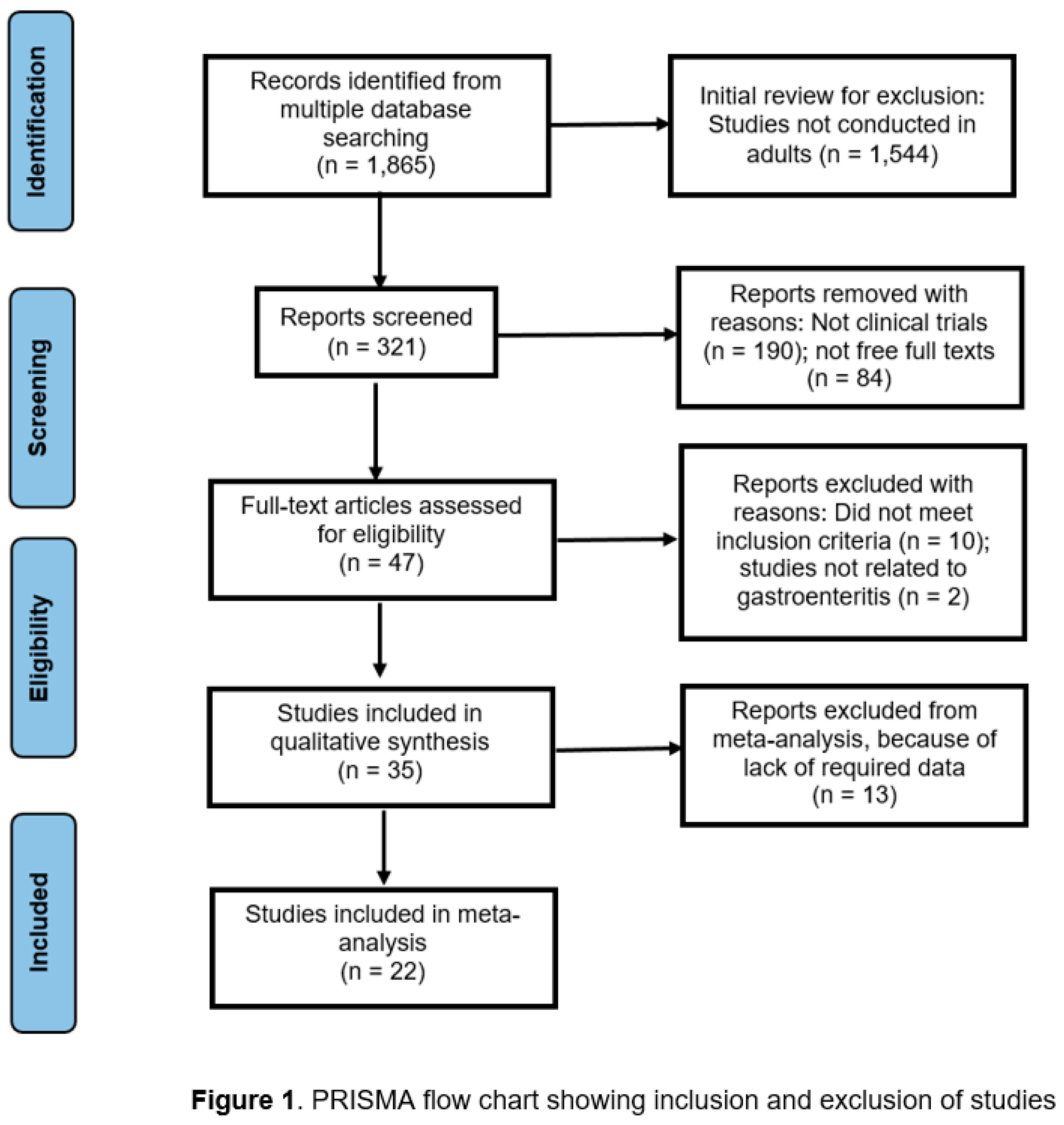
Figure 2.
Types of infections causing diarrhea among the study samples (n = 35).
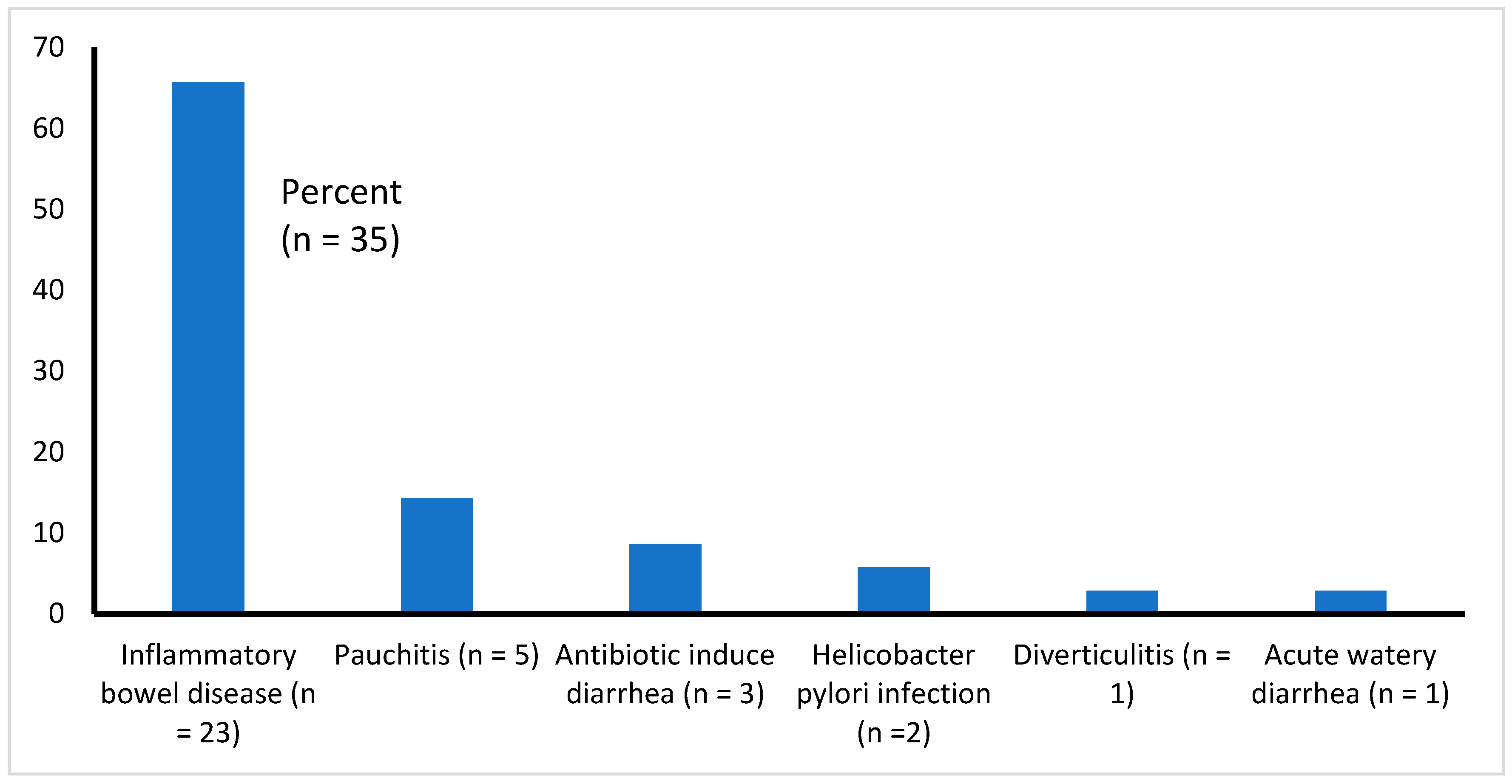
Figure 3.
The Forest plot for the pooled analysis of 22 included studies.
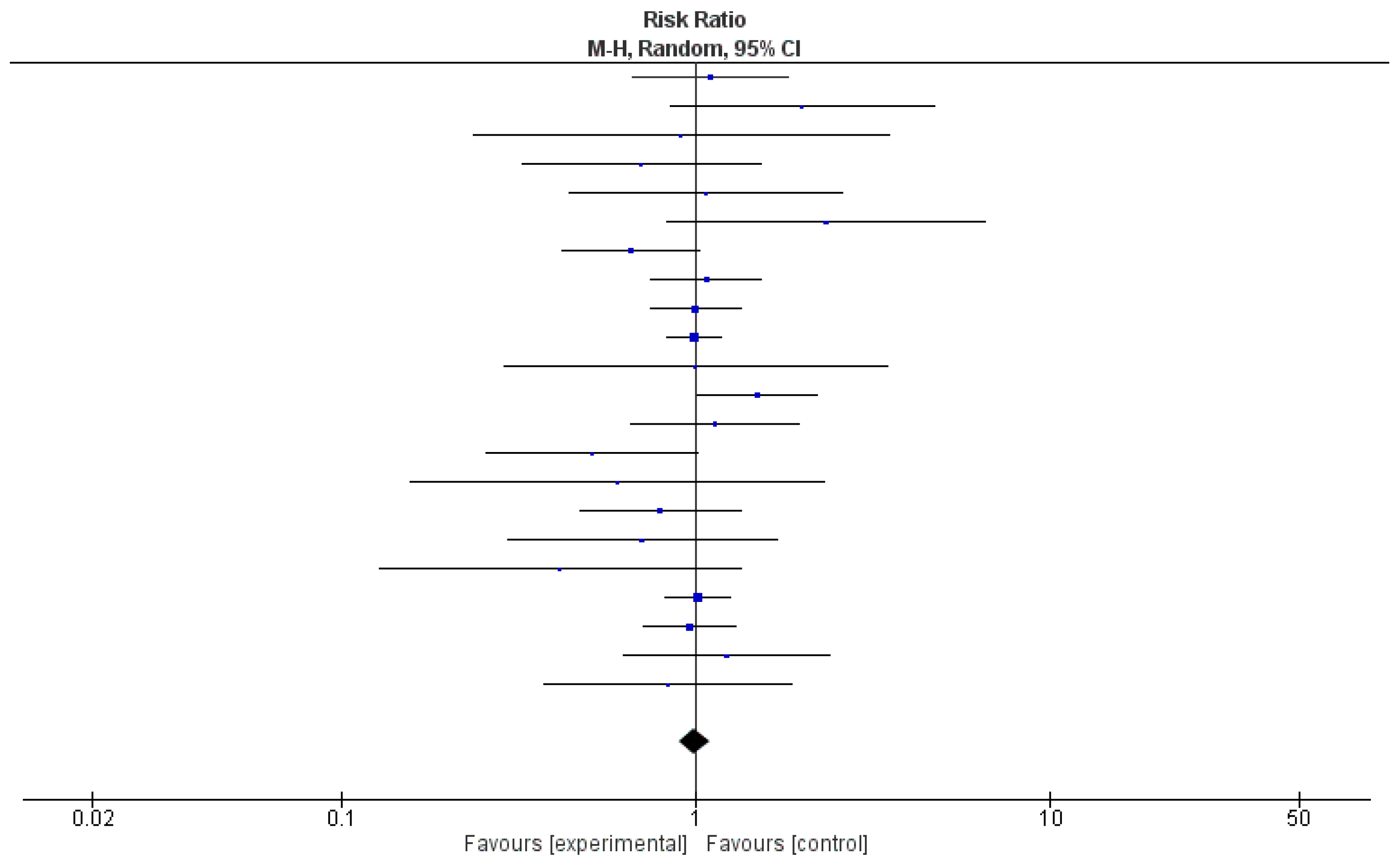
Figure 4.
Risk of bias graph: review authors’ judgements about each risk of bias item presented as percentages across all included studies.
Figure 4.
Risk of bias graph: review authors’ judgements about each risk of bias item presented as percentages across all included studies.
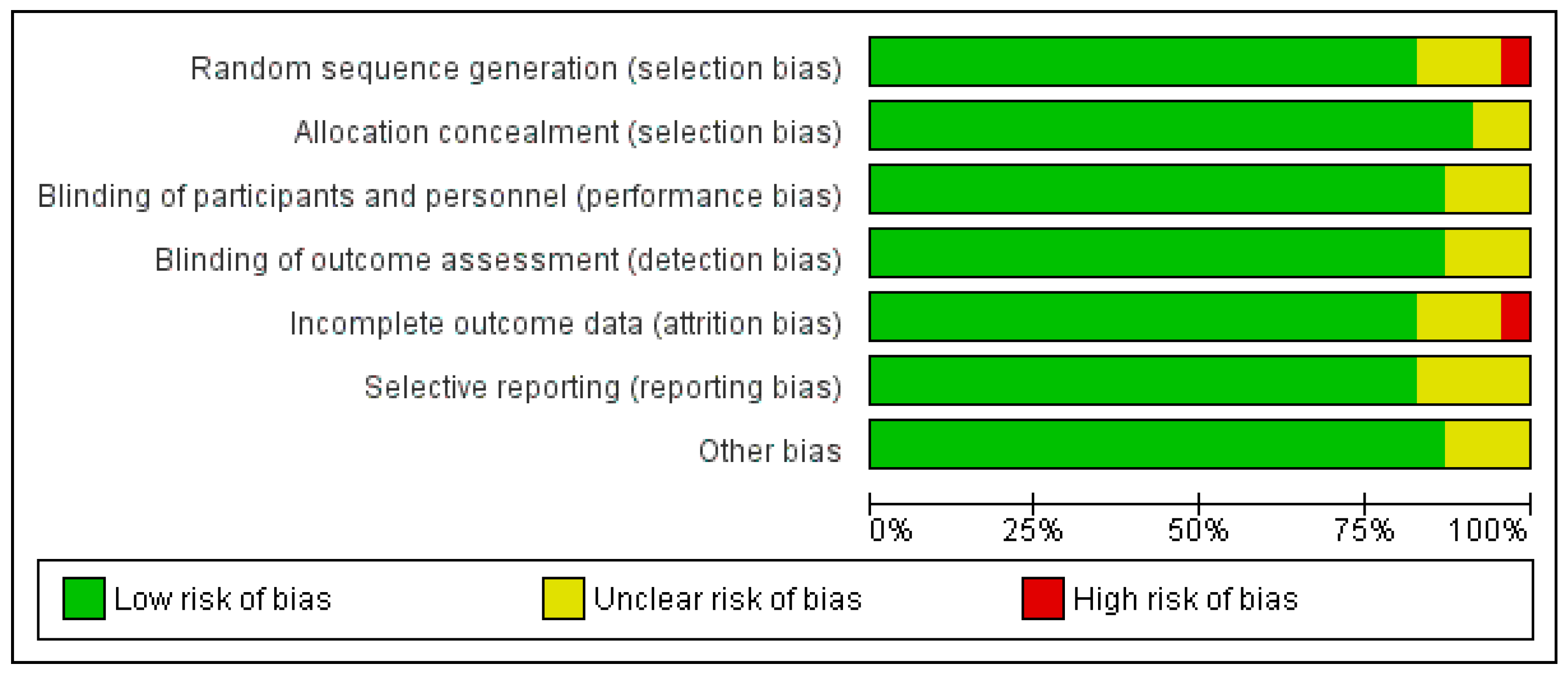
Figure 5.
Risk of bias summary.
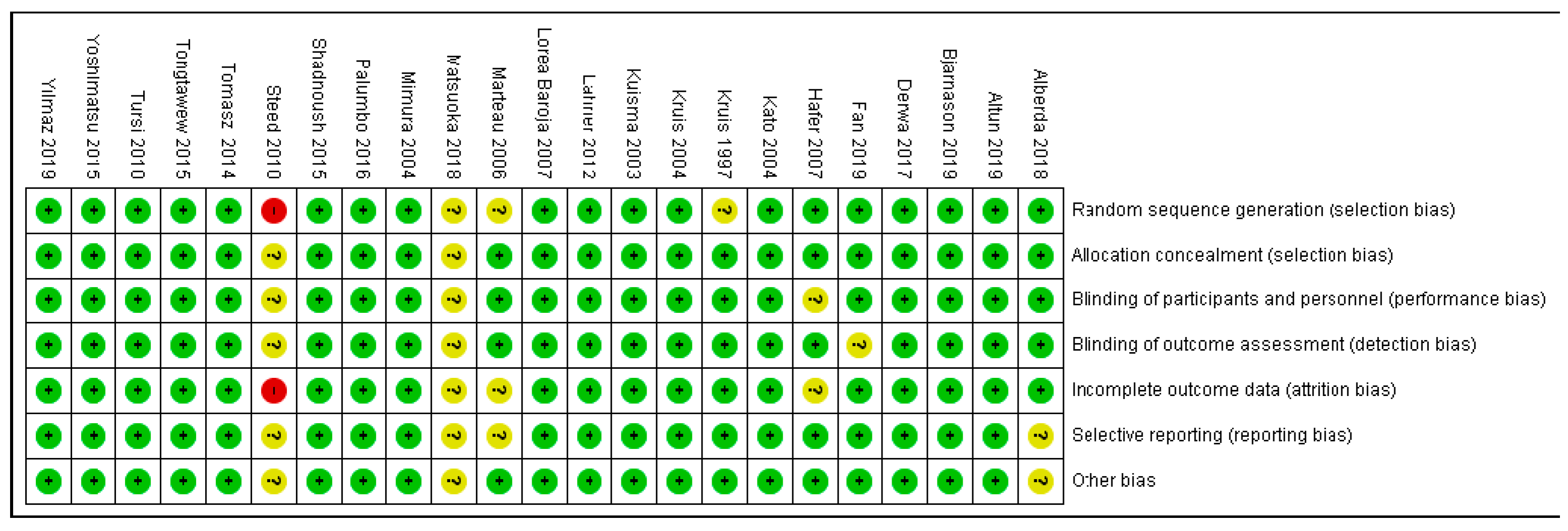
Figure 6.
A funnel plot to assess publication bias.
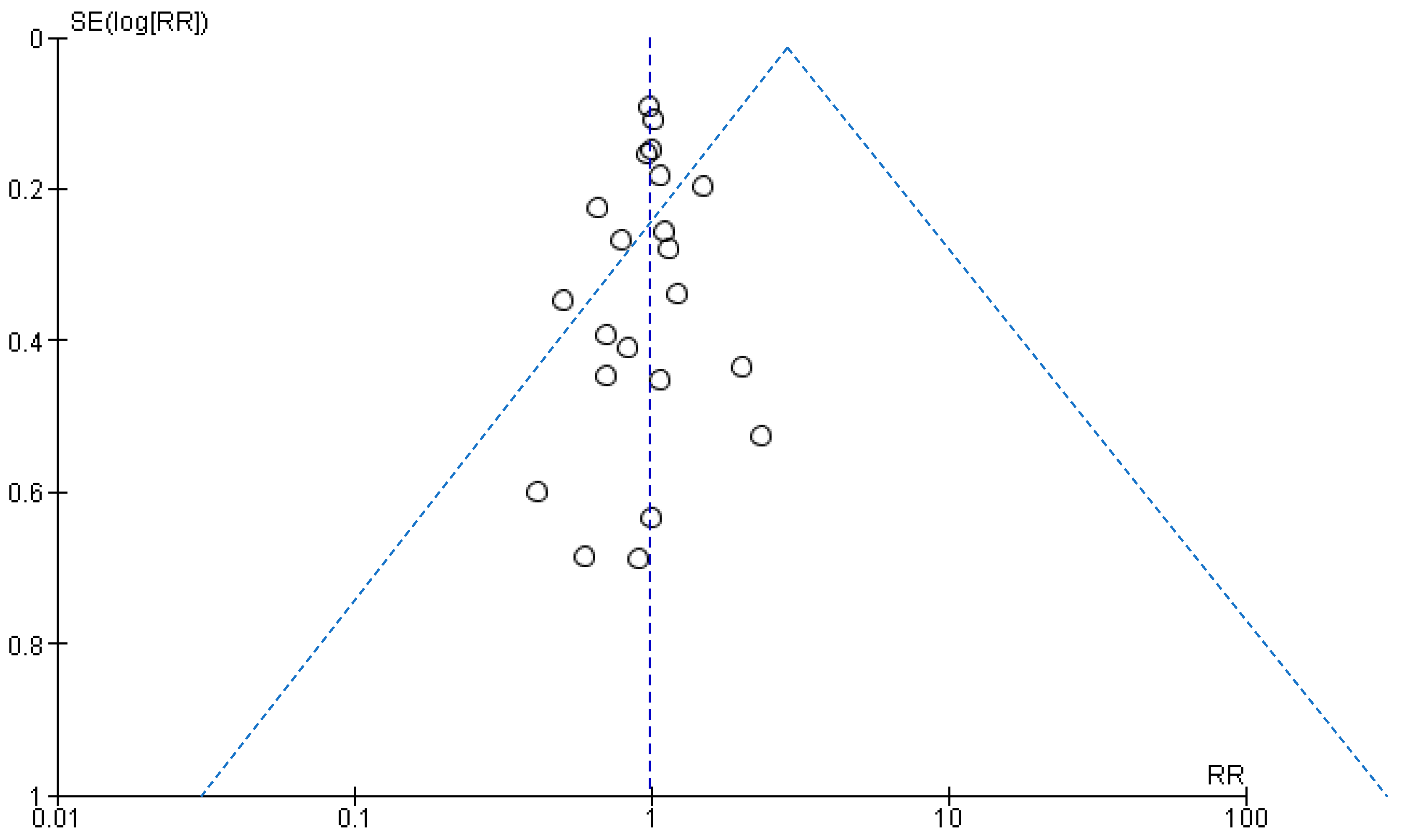
Table 1.
Type of gastroenteritis, probiotics used, and their effectiveness.
| Authors, year [ref.] | Disease condition and sample size | Type of probiotics used | Prevention / Treatment | Effective | Quality appraisal | Major findings / conclusions | Country |
| Alberda et al., 2018 [11] | Antibiotic-associated diarrhea (AAD) and Clostridium difficile-induced diarrhea; sample size = 32 | Lactobacillus casei | Prevention | Yes | Score 3 out of 4 (Moderate) | Probiotic drink can prevent AAD and Clostridium difficile infections. | Canada |
| Altun, et al., 2019 [12] | Inflammatory bowel disease (IBD)1: ulcerative colitis (UC); sample size = 40 | Enterococcus faecium, Lactobacillus plantarum, Streptococcus thermophilus, Bifidobacterium lactis, Lactobacillus acidophilus, Bifidobacterium longum)-and fructooligosaccharide | Treatment | No | Score 4 out of 4 (High) | The use of synbiotic therapy2 had no statistically significant effect in the improvement of clinical and endoscopic parameters compared with controls. | Turkey |
| Bjarnason, et al., 2019 [13] | IBDs: ulcerative colitis (UC) (n = 81) and Crohn’s disease (n = 61); total samples more than 500. | Symprove contains multiple strains of probiotics such as Lactobacillus plantarum, Lactobacillus rhamnosus, Lactobacillus plantarum, Lactobacillus acidophilus, and E. faecium | Treatment | Yes | Score 4 out of 4 (High) | Multi-strain probiotics decreased intestinal inflammation in patients with ulcerative colitis, but not in patients with Crohn’s disease. | United Kingdom |
| Derwa, et al., 2017 [14] | IBDs; sample size = 777 | Probiotics vs.5-aminosalicylates (5-ASAs) (in one RCT); probiotics vs. placebo (in 7 RCTs). | Treatment | No | Score 4 out of 4 (High) | There was no benefit of probiotics over 5-ASAs4 or placebo in inducing remission in active inflammatory bowel diseases. For ulcerative colitis, relative risk of failure to achieve remission = 0.86; 95% CI = 0.68-1.08. | Multiple countries |
| Fan, et al., 2019 [15] | IBDs1; sample size = 40 | Bifico contains probiotic bacteria Bacillus Coagulans GBI-30, 6086. Bifico was given as an adjuvant treatment with Pentasa, which is an anti-inflammatory agent. | Treatment | Yes | Score 4 out of 4 (High) | Combination of probiotics and pentasa can improve microflora composition in patients with IBD and reduce the level of inflammatory cytokines. | China |
| Groeger, et al., 2013 [16] | IBDs1; chronic fatigue syndrome (CFS); Psoriasis. Sample sizes: UC = 22, CFS = 48, psoriasis = 26. | Bifidobacterium infantis 35624 | Treatment | Yes | Score 4 out of 4 (High) | Microbiota in humans have immuno-modulatory effects on both mucosal immune system and systemic immune system. | Ireland |
| Hafer, et al., 2007 [17] | IBDs1; sample sizes: UC = 14, Crohn’s disease = 17. | Standard treatment vs. standard treatment with oral lactulose. | Treatment | No | Score 3 out of 4 (Moderate) | Oral lactulose has no beneficial no clinical and immune-histological effects on IBD patients. | Germany |
| Kato, et al., 2004 [18] | IBD: ulcerative colitis (UC); sample size = 20 | Bifidobacteria-fermented milk (BFM) | Treatment | Yes | Score 3 out of 4 (Moderate) | Supplementation with BFM has beneficial effects in managing active ulcerative colitis and is more effective than the conventional treatment alone. | Japan |
| Krag, et al., 2012 [19] | IBD: ulcerative colitis (UC); sample size = 39 | Profermin, consisting of fermented oats, Lactobacillus plantarum 299v, barley malt, lecithin, and water | Treatment | Yes | Score 4 out of 4 (High) | Profermin is safe and may be effective in inducing remission of active ulcerative colitis. | Denmark |
| Kruis, et al., 1997 [20] | IBD: ulcerative colitis (UC); sample size = 120 | Escherichia coli Nissle (Serotype 06: K5: H1), as an adjuvant treatment with mesalazine (also known as 5-aminosalicylic acid (5-ASA)4 | Treatment | Yes | Score 4 out of 4 (High) | E. coli (Serotype 06: K5: H1) is effective in preventing remission of ulcerative colitis as a standard treatment with 5-ASA4. | Germany, Czech Republic, and Austria |
| Kruis, et al., 2004 [21] | IBD: ulcerative colitis (UC); sample size = 327 | Escherichia coli Nissle 1917 | Maintaining remission and prevention of relapses | Yes | Score 4 out of 4 (High) | Probiotic EcN has therapeutic effects and is safe for maintaining remission in ulcerative colitis. EcN can be used as an alternative of 5-ASA4. | Germany |
| Kuehbacher, et al., 2006 [22] | Pouchitis3; sample size = 15 | VSL #3 consists of Lactobacillus casei, L. plantarum, L. acidophilus, L. bulgaricus, Bifidobacterium longuum, B. breve, B. infantis, and Streptococcus salivarius sub-spp. Thermophillus | Treatment | Yes | Score 3 out of 4 (Moderate) | Probiotic therapy with VSL #3 increases the diversity, richness and total number of intestinal bacteria and bacterial microbiota. | Germany |
| Kuisma, et al., 2003 [23] | Pouchitis3; sample size = 20 | Lactobacillus rhamnosus GG | Treatment | No | Score 3 out of 4 (Moderate) | Lactobacillus GG can alter the microbial flora in ileo-anal pouches but was inefficient for clinically improving pouch inflammation. | Finland |
| Lahner, et al., 2012 [24] | Symptomatic uncomplicated diverticular disease; sample size = 45 | Lactobacillus paracasei B21060 (symbiotic sachet Flortec©) plus high fiber diet (Treatment Group) vs high fiber diet only (Controls) | Treatment | Yes | Score 3 out of 4 (Moderate) | The treatment group having symbiotic sachet Flortec© plus a high fiber diet improved of clinical symptoms (abdominal pain, bloating) significantly more than the control group. | Italy |
| Lorea Baroja, et al., 2007 [25] | IBD: Crohn’s disease (n = 15) and ulcerative colitis (n = 5), control, (n = 20); total sample size = 40 | Lactobacillus rhamnosus GR-1 and L. reuteri RC-14- supplemented yogurt vs. placebo | Prevention | Yes | Score 4 out of 4 (High) | Short-term consumption of probiotic yogurt with Lactobacillus rhamnosus GR-1 and RC-14 has beneficial immune modulatory effects. | Canada |
| Marteau, et al., 2006 [26] | IBD: Crohn’s disease; sample size = 98 | Lactobacillus johnsonii LA1 | Prevention of relapses | No | Score 4 out of 4 (High) | Lactobacillus johnsonii LA1 have no sufficient effect to prevent recurrence of Crohn’s disease. | France |
| Matsuoka, et al., 2018 [27] | IBD: ulcerative colitis (UC); sample size = 195 | Bifidobacterium breve fermented milk (BFM) | Prevention | No | Score 4 out of 4 (High) | BFM had no effect on time to relapse in UC patients, compared with placebo. | Japan |
| Matthes, et al., 2010 [28] | IBD: ulcerative colitis (UC); sample size = 90 (70 with UC and 20 controls) | Escherichia coli Nissle 1917 (EcN) | Treatment | Yes | Score 3 out of 4 (Moderate) | Escherichia coli Nissle 1917 (EcN) may be an alternative treatment for moderate distal ulcerative colitis. | Germany |
| Mimura, et al., 2004 [29] | Recurrent or refractory pouchitis3; sample size = 36 | VSL #3 contains Lactobacillus casei, L. plantarum, L. acidophilus, L. bulgaricus, Bifidobacterium. longuum, B. breve, B. infantis Streptococcus salivarius subsp. Thermophillus | Treatment of remission | Yes | Score 3 out of 4 (Moderate) | VSL#3 probiotic therapy is highly effective in maintaining treatment of recurrent pouchitis3 and improving quality of life. | United Kingdom and Italy |
| Mitra & Rabbani, 1990 [30] | Acute watery diarrhea due to Vibrio cholerae and E. coli infection; sample size = 183 | Bioflorin (Streptococcus faecium SF68), given orally along with intravenous rehydration, and followed by oral rehydration solution | Treatment | No | Score 4 out of 4 (High) | Bioflorin was not effective in treating acute diarrhea due to V. cholerae and enterotoxigenic E. coli infections. | Bangladesh |
| Montalto, et al., 2010 [31] | Non-steroidal anti-inflammatory drug-induced enteropathy; sample size = 20 | VSL #3 contains Lactobacillus casei, L. plantarum, L. acidophilus, L. bulgaricus, Bifidobacterium. longuum, B. breve, B. infantis Streptococcus salivarius subsp. Thermophillus | Treatment | Yes | Score 2 out of 4 (Poor) | Probiotics mixture could be useful in decreasing indomethacin-induced intestinal inflammation. | Italy |
| Palumbo, et al., 2016 [32] | IBD: ulcerative colitis (UC); sample size = 60 | A probiotic blend, which consists of Lactobacillus salivarius, Lactobacillus acidophilus and Bifidobacterium bifidus strain BGN4, given as an adjuvant therapy with Mesalazine | Treatment | Yes | Score 3 out of 4 (Moderate) | Long-term treatment modality of anti-inflammatory drugs and probiotics is viable and could be an alternative treatment for mild-to moderate ulcerative colitis. | Italy |
| Persborn, et al., 2013 [33] | Pouchitis3; sample size = 16 patients with pouchitis and 13 controls with a healthy ileoanal pouch | Bifidobacterium bifidum (W23), B. lactis (W51), B. lactis (W52), Lactobacillus acidophilus (W22), L. casei (W56), L. paracasei (W20), L. plantarum (W62), L. salivarius (W24), L. lactis (W19) | Treatment | Yes | Score 3 out of 4 (Moderate) | Probiotics restored the mucosal barrier to E. coli in patients with pouchitis3. This can prevent recurrence during maintenance therapy. | Sweden |
| Shadnoush, et al., 2015 [34] | IBDs1; sample size = 305, of which 105 IBD patients received probiotic yogurt, 105 IBD patients received placebo, and 95 healthy controls received probiotic yogurt | Probiotic yogurt containing Lactobacillus acidophilus La-5 and Bifidobacterium BB-12 | Treatment | Inconclusive | Score 3 out of 4 (Moderate) | Fiber and energy intake in the treatment group did not increase when compared with those of controls. However, consumption of probiotic yogurt by patients with IBD may help to increase the number of probiotic bacteria in the intestine, thus improving intestinal function. | Iran |
| Shen, et al., 2005 [35] | Antibiotic-dependent pouchitis3; sample size = 31 | VSL #3 contains four strains of Lactobacillus, three Bifidobacterium species, Streptococcus salivarius subsp. thermophillus | Treatment | Yes | Score 3 out of 4 (Moderate) | The use of probiotics is useful, and the authors suggested it in routine clinical care. | United States |
| Steed, et al., 2010 [36] | IBD: Crohn’s disease; sample size = 35 | Bifidobacterium longum and Synergy 1 which contains Orafti, Tienen, Belgium | Treatment | Yes | Score 4 out of 4 (High) | Effective in improving clinical symptoms in patients with active Crohn's disease. | Scotland |
| Tomasz, et al., 2014 [37] | Pouchitis3; sample size = 43 | Lactobacillus acidophillus, L. delbrueckii subsp. bulgaricus, and Bifidobacterium bifidus | Prevention | Yes | Score 4 out of 4 (High) | Long-term use of probiotics is safe and can be an effective method of preventing pouchitis3. | Poland |
| Tongtawee, et al., 2015 [38] | Helicobacter pylori; sample size = 200 | Lactobacillus delbrueckii subsp. bulgaricus and Streptococcus thermophillus | Treatment | Yes | Score 4 out of 4 (High) | Pretreatment with probiotic containing yogurt can potentiate the effects of triple therapy for Helicobacter pylori. | Italy |
| Tursi, et al., 2010 [39] | IBD: ulcerative colitis (UC); sample size = 144 | VSL #3 consists of Lactobacillus casei, L. plantarum, L. acidophilus, L. bulgaricus, Bifidobacterium longuum, B. breve, B. infantis, and Streptococcus salivarius sub-spp. Thermophillus | Treatment | Yes | Score 4 out of 4 (High) | High potency probiotic mixture supplementation is safe and improves rectal bleeding and reduce remission in relapsing ulcerative colitis patients after 8 weeks of treatment. | Thailand |
| Venturi, et al., 1999 [40] | IBD: ulcerative colitis (UC); sample size = 20 | VSL #3 consists of Lactobacillus casei, L. plantarum, L. acidophilus, L. bulgaricus, Bifidobacterium longuum, B. breve, B. infantis, and Streptococcus salivarius sub-spp. Thermophillus | Treatment | Yes | Score 3 out of 4 (Moderate) | Intake of VSL #3 preparation enhances the concentrations of some strains of protective bacteria in the intestinal microflora. | Italy |
| Yilmaz, et al., 2019 [41] | IBDs1; sample size = 45 | Kefir, a cultured, fermented beverage, which contains Lactobacillus bacteria | Treatment | Yes | Score 3 out of 4 (Moderate) | Consumptions of kefir has short term effects on improving the quality of life of patients. | Turkey |
| Yoshimatsu, et al., 2015 [42] | IBD: ulcerative colitis (UC); sample size = 46 | Streptococcus faecalis (lactomin), Clostridium butyricum, and Bacillusmesentericus | Prevention of relapse | Yes | Score 3 out of 4 (Moderate) | Probiotics may be effective for maintaining clinical remission in patients with quiescent ulcerative colitis. | Japan |
| Ziemniak, 2006 [43] | Chronic gastritis, or duodenal ulcer caused by Helicobacter pylori; sample size = 641 | Lacidofil containing Lactobacillus acidophilus and Lactobacillus rhamnosus, as an adjuvant therapy with antibiotics and proton pump inhibitor (PPI) | Treatment | Yes | Score 4 out of 4 (High) | Lacidofil increases the efficacy of clarithromycin and amoxicillin and also reduces complications of antibiotic therapy. | Poland |
| Zocco, et al., 2006 [44] | IBD: ulcerative colitis (UC); sample size = 187 | Lactobacillus GG | Treatment and prevention of remissions | Yes | Score 4 out of 4 (High) | Lactobacillus GG is effective and safe for maintaining ulcerative colitis remission and could be a good therapeutic alternative. | Italy |
| Zwolinsk, et al., 2009 [45] | IBD: ulcerative colitis (UC); sample size = 101, of which 56 had active phase of UC, 33 non-active phase of UC, and 12 IBS controls | Lacidofil, containing two well-characterized strains of Lactobacillus: L. helveticus R-52 and L. rhamnosus R-11. | Treatment | Yes | Score 4 out of 4 (High) | Probiotic therapy is beneficial in counteracting the effects of delayed healing of trinitrobenzene sulfonic acid induced colitis caused by Candida. | Poland |
1Inflammatory bowel diseases include ulcerative colitis and Crohn’s disease; 2Synbiotic therapy: a combination of prebiotics and probiotics; 3Pouchitis: inflammation of a J-shaped pouch, which is created by surgical procedures as a treatment of ulcerative colitis; 45-ASA: 5-aminosalicylates; mesalazine is a 5-ASA.
Table 2.
Effectiveness of probiotics, as evaluated by meta-analyses.
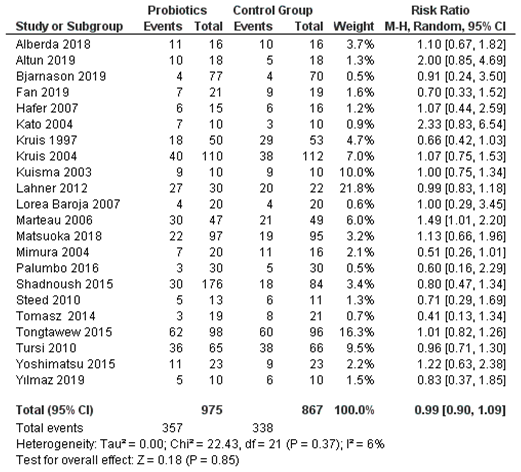 |
Disclaimer/Publisher’s Note: The statements, opinions and data contained in all publications are solely those of the individual author(s) and contributor(s) and not of MDPI and/or the editor(s). MDPI and/or the editor(s) disclaim responsibility for any injury to people or property resulting from any ideas, methods, instructions or products referred to in the content. |
© 2023 by the author. Licensee MDPI, Basel, Switzerland. This article is an open access article distributed under the terms and conditions of the Creative Commons Attribution (CC BY) license (https://creativecommons.org/licenses/by/4.0/).
Copyright: This open access article is published under a Creative Commons CC BY 4.0 license, which permit the free download, distribution, and reuse, provided that the author and preprint are cited in any reuse.
MDPI Initiatives
Important Links
© 2024 MDPI (Basel, Switzerland) unless otherwise stated







